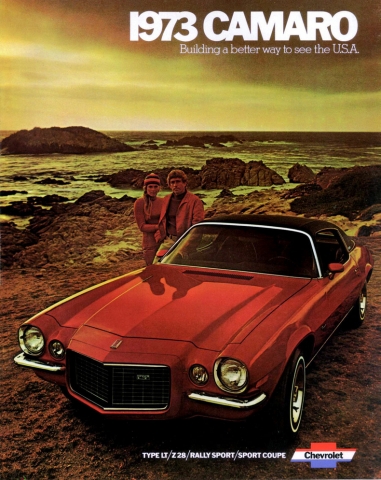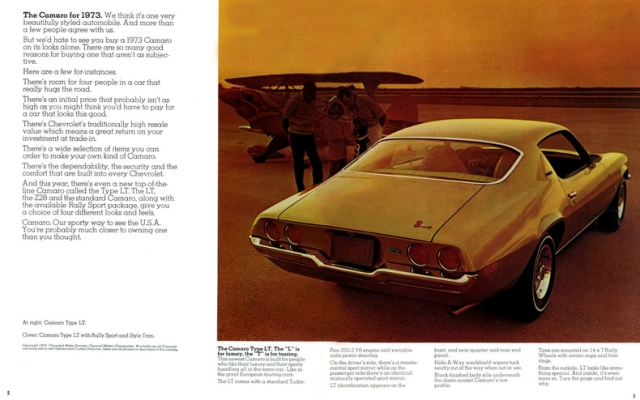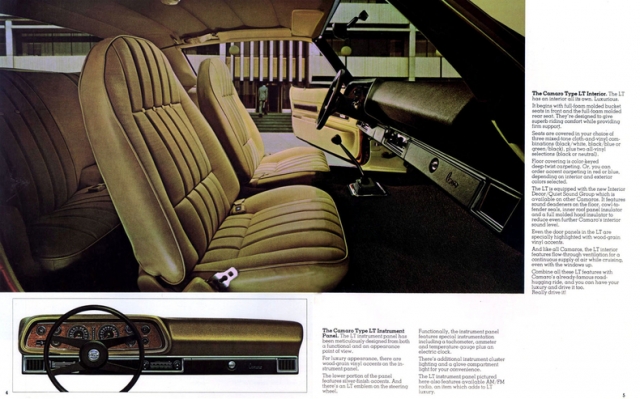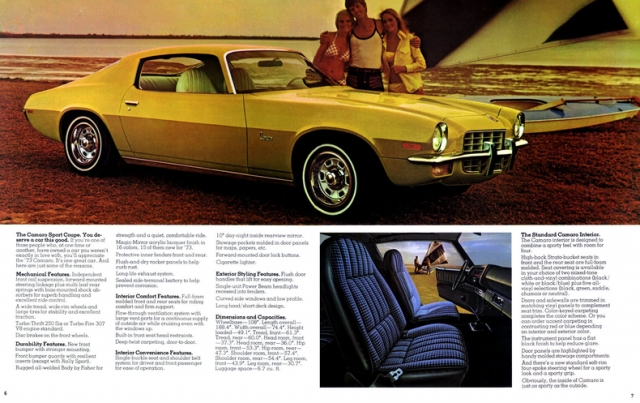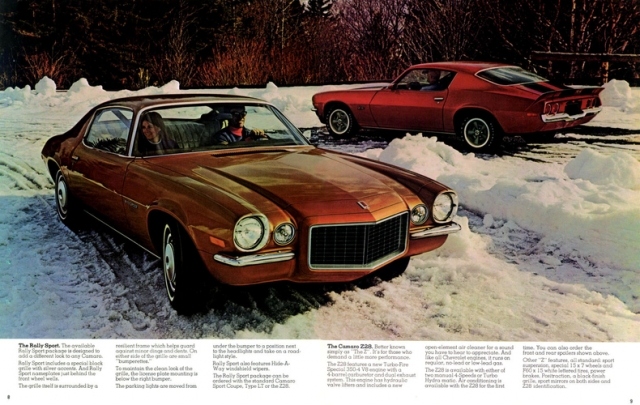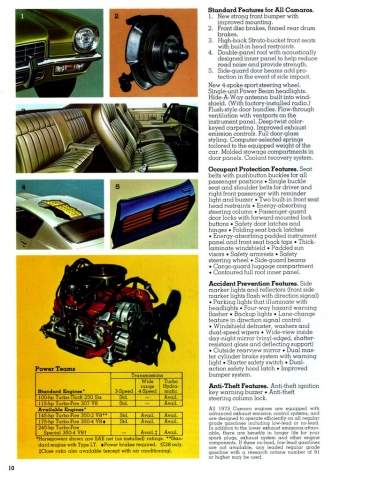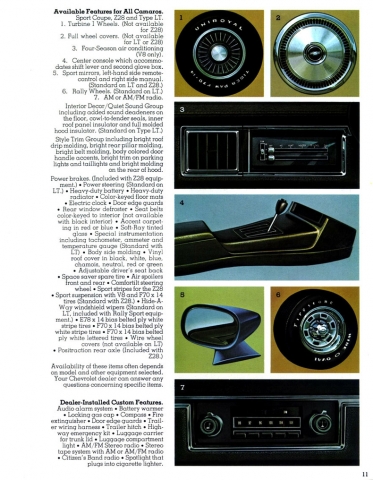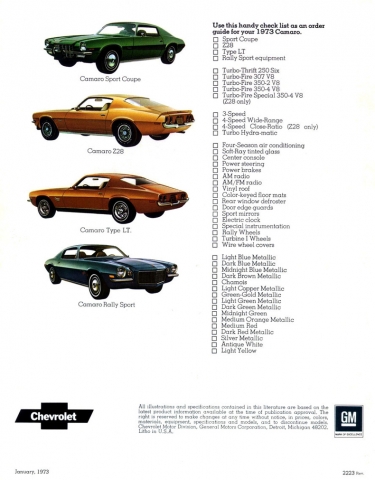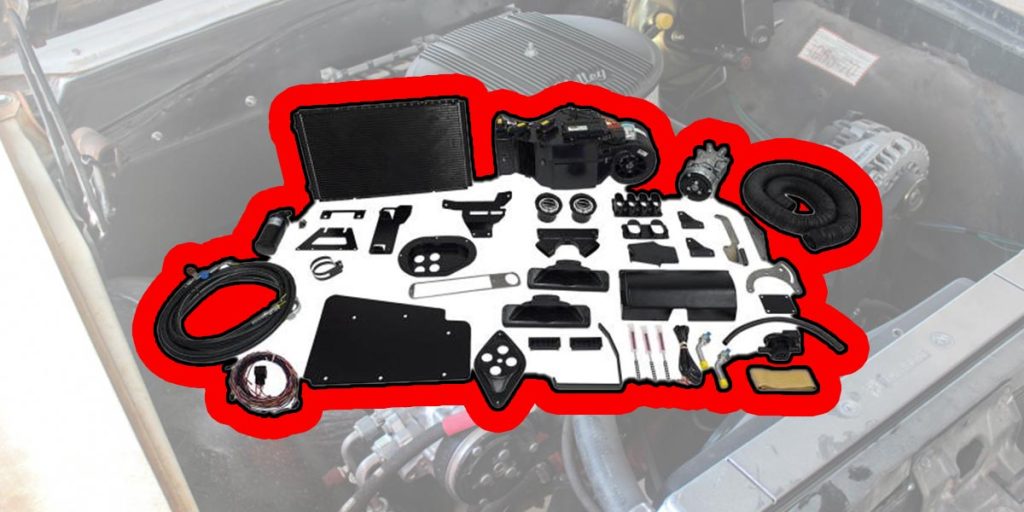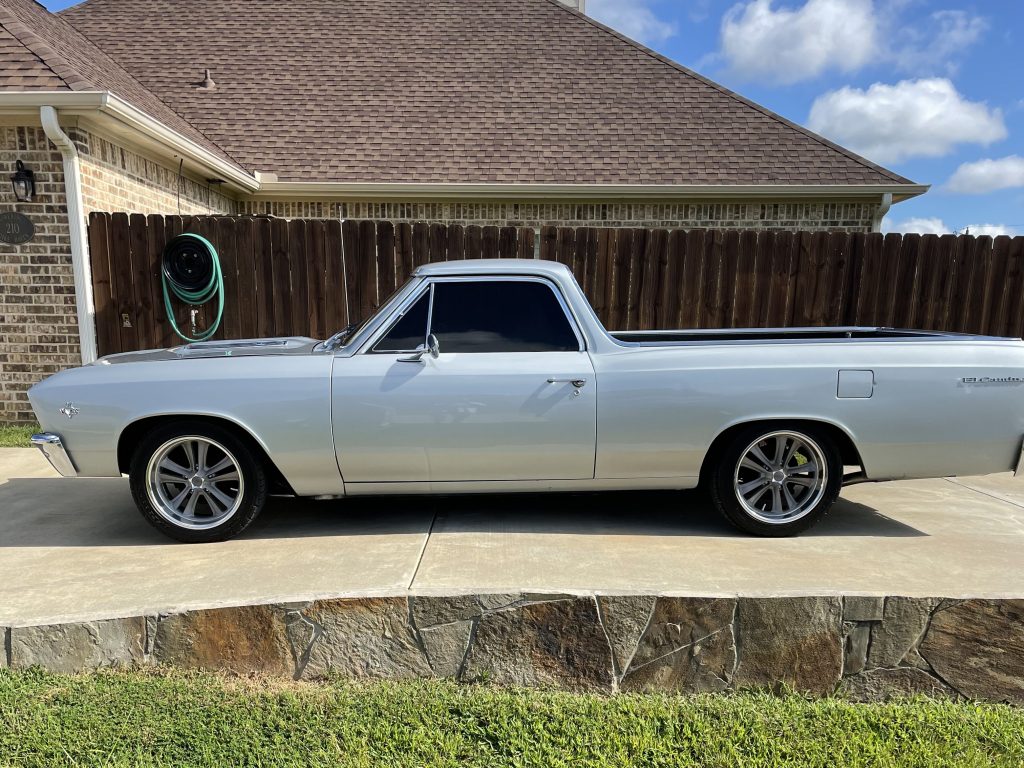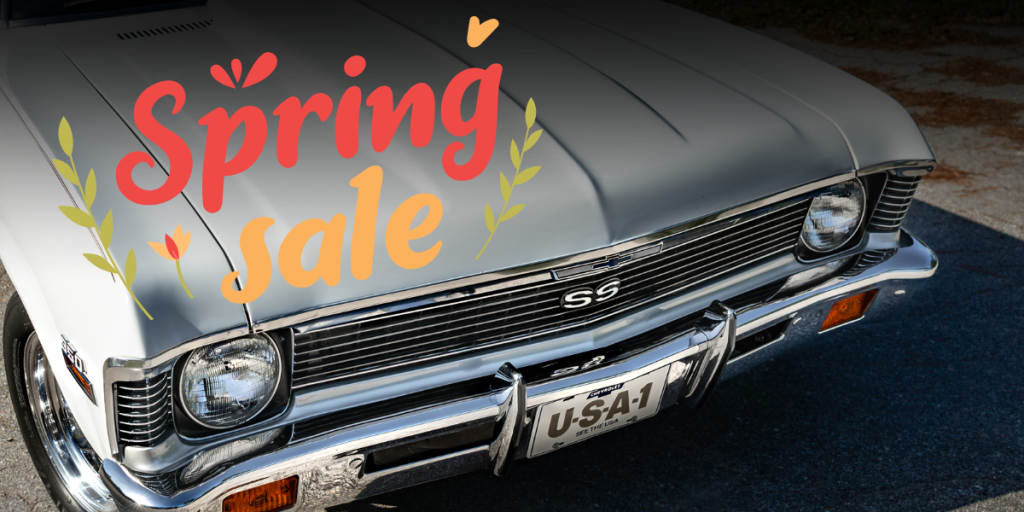1973 Camaro Specifications
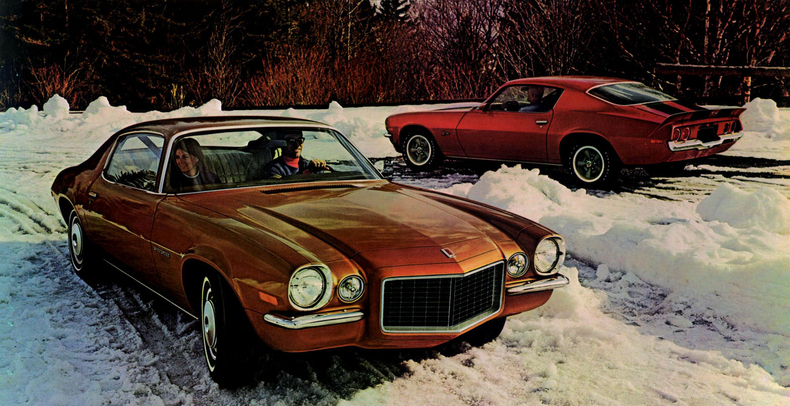
1973 appeared promising for the Camaro despite the previous year’s problems and continued turmoil from Federal regulations.
Sales slightly increased from the previous year due to Chevy’s engineering of the Camaro’s bumper. While the rest of the industry was installing battering ram-style bumpers on their cars, Chevy was able to engineer bumpers that would pass Federal regulations including the Rally Sport split bumper design.
The 1973 Camaro saw a nicer interior and the SuperSport option was no longer offered. The SuperSport option was replaced with the Stylish Type LT model. The Type LT model was added as a luxury package and included a V8 (L65) and several trim items. The Camaro LT could have been ordered with RPO code Z28, and if the Rally Sport option was also ordered, you could have yourself a Type LT/RS/Z28 Camaro.
While the Z28 was still being cut down power-wise, air conditioning was available for the 1st time on the Z28. Fans were also sadly disappointed to find out that the 396 big-block V8 was no longer available. Despite all the drops in performance, production was up for the 1973 Camaro!
1973 Spotters Guide & New Features
- RPO Z27 (SS) dropped, replaced with Type LT
- Formerly optional steering wheel (NK4) became standard
- New impact-absorbing bumpers; RS kept bumperettes, but they were stiffened up
- Singlestick ratcheting shifter replaced stirrup model
- Z/28 could get air conditioning (due to non-mechanical lifters)
- New wheel selections
- RPO Z87 Custom Interior dropped
- Perforated headliner replaces Cut & Sew style in mid-year
- Space-saver tire debuted
- Redesigned console
- Power windows debuted
- Full foam rear seats with one-piece backrest
- Powerglide 2-speed automatic transmission dropped
- EGR for all engines & coolant-recovery
- Warning buzzer/fasten seat belts debuted
- Tail-light housing switched from black to white plastic
Click here for Second Generation Camaro Spotters Guide & Summary of Yearly Changes
1973 Chevrolet Camaro Brochure
1973 Camaro Model Options
Engine Options:
- 250 cubic inch 100 horsepower 6-cylinder (Base L6, 1 bbl carb)
- 307 cubic inch 115 horsepower V8 (Base V8, 2 bbl carb)
- L65 – 350 cubic inches 145 horsepower V8 (Base Type LT, 2 bbl carb)
- L48 – 350 cubic inches 175 horsepower V8 (optional, 4 bbl carb)
- Z28 – 350 cubic inches 245 horsepower V8 (Z28 only, 4 bbl carb)
1973 Camaro Production:
- 3,614 6-cyl
- 93,137 V8
- 96,751 total
Dealer Introduction: 9/21/72
Vehicle Identification Example: 1Q87T3N182396
- First digit is GM Division: 1 = Chevrolet
- Second digit is model series: Q = Sport Coupe S = Type LT Coupe
- Digits 3 & 4 are body type: 87 = 2dr. Coupe
- Fifth digit is engine code: D = 250ci, F = 307ci, H = 350ci, tb, K = 350ci 4bbl, T = 350ci, z
- Sixth digit is model year: 3 = 1973
- The seventh digit is N for Norwood assembly.
- The last six digits increased one with each car built at Norwood, the sequence started at 100001
Dimensions & Capacities:
- Length: 188.5″
- Height: 49.1″
- Width: 74.4″
- Wheelbase: 108.0″
- Track F/R: 61.3/60.0
- Weight Distribution F/R: 57.3 / 42.7%
- Ground Clearance: 4.2″
- Fuel Capacity: 18.0 Gal
- Battery Capacity: 12 volt 61 amp/hr
- Alternator Capacity: 854 watts
Curb Weight:
- 1FQ87 – 3205 lbs.
- 1FS87 – 3435 lbs.
1973 Ending VIN by Month
- Norwood
- Oct – 101566
- Nov – 108449
- Dec – 119821
- Jan – 134347
- Feb – 146720
- Mar – 156034
- Apr – 165811
- May – 175138
- Jun – 184580
- Jul – 196752
- Van Nuys
- None built in 1973
1973 Camaro Model Option Breakouts
Z21 Style Trim
Includes body-colored insert on door handles, bright window, body, sill, and hood panel moldings plus bright accented parking lights, taillights, and backup lights. (NOT included with Rally Sport option)
Z22 Rally Sport
Includes special black-painted grille with special rubber-tipped vertical center bar and resilient body-color grille frame; independent LH and RH front bumpers replacing full-width bumper; license plate bracket mounted below RH bumper; parking lights with bright accents mounted on grille panel; Hide-a-Way windshield wipers with black-chrome finished arms and articulated left hand blade; bright window, hood panel, and body sill moldings; body-colored insert on door handles; RS emblem on the steering wheel; Rally Sport front fender nameplates; bright accented taillights and backup lights. (RS emblems deleted with Z28 option).
The 1973 Rally Sport front end contains additional reinforcing bars from the fenders to the core support and from the core support to the urethane nose. These were required to pass new Federal bumper regulations
Click here for information on how to verify a Rally Sport
Z28 Special Performance Package
Air conditioning became available as a Z28 option for the first time, and an A/C option with manual trans required M20. The rear “Z28 emblem” is now a foil decal. Price of Z28 package lowered. The Z28 option could be ordered/combined on the Type LT model. U14 Instrumentation is now optional.
Total Production: 11,574
- Manual: 6,107
- Automatic: 5,467
Z28 Vin Verification:
The 5th digit of the VIN will read “T”.
Engine:
Includes special 350ci V8 rated 245 hp, 10hp less than the previous year. Torque still at 280, Four-bolt main bearing caps, forged steel crank, “big valve” cylinder heads. Cast aluminum rocker covers with internal galleries. Hydraulic lifters replaced solid ones. Aluminum high-rise manifold eliminated, replaced by cast iron intake with EGR. Rochester Quadra jet replaced Holley 4-barrel. Dual exhaust pipe system. A 17-quart cooling system replaced the 15-quart system used since 1970.
1973 Z28 Carburetor (Rochester Quadra Jet 4MV)
Transmission & Clutch:
Close ratio Muncie 4-speed & 11 inch clutch standard, with special 2400-RPM-stall torque converter Turbo 400 optional. If car was equipped with air conditioning and manual trans, the M20 wide-ratio transmission was used.
Rear Axle:
Positraction standard, 4.10:1 axle dropped. 3.42 for A/T, 3.73 for M/T. No options.
Brakes:
11-inch, vented, cast-iron front disc brakes with vacuum assist standard. Rear 9.5-inch drums. (unchanged since 1970)
Front Suspension:
Spring rate: 300 lb./in. Front stabilizer bar 0.938 inch.
Rear Suspension:
Spring rate: 89-99 lb./in. Rear stabilizer bar 0.69 inch.
Steering:
Recirculating ball, variable ratio, power assist. 2.8 (or 6) turns, lock to lock, 38.5 ft. turning radius.
Power steering had straight 16:1 ratio and was re-valved to give more road feel. Unchanged from 1972.
Wheels & Tires:
15″ x 7″ steel wheels painted dull grey with bright lug nuts, center caps with blue bowtie and trim rings,
Wheel Code: AU, Part #: 3983045, Center cap part #: 3989479, Trim ring part #: 3984524.
F60-15 fiberglass-belted white letter tires standard. (unchanged from & identical to 1970)
Click here to see the specific 1973 Z28 Chassis Specifications.
Z28 Performance Test Data
Source: Car & Driver – 9/73: Test Vehicle: 1973 Type LT Z28/RS, 4 speed, 3.42:1
Standing 1/4 mile:
15.2 sec. @ 94.6 MPH
Top Speed (Observed):
123 MPH
70 – 0 MPH:
192 ft. (0.85G)
Fuel Mileage:
10.0 – 13.5 MPG / regular fuel
Cruising Range:
180 – 240 miles
Interior Sound Level:
76 (dBA) / 70 MPH cruise, 85 (dBA)/ full throttle
Z54 Interior Decor / Quiet Sound
Includes glove compartment light and additional instrument cluster lighting; wood grain accents on instrument cluster; special engine compartment, hood and interior insulation. (Standard with Type LT)
Type LT
Included 2 barrel 165hp V8, 7″ rally wheels, variable ratio power steering, hidden wipers, blackout rocker sills and moldings, sport mirrors right and left, full instrumentation (U14), extra body and hood insulation, deluxe seat trim, bright beaded woodgrain trim on the instrument panel and doors and LT emblems on the steering wheel and exterior. You could combine RPO Z28 with the LT
1973 Camaro Engine Codes & Specs
Available Engine Specifications
6-Cylinder Engine Codes
8-Cylinder Engine Codes
Engine Code Example: V0427CLJ
(350 – 245hp Assembled in Flint assembly plant on April 27)
1973 Camaro Transmission Codes
Transmission Code Example: P3D27B
(1973 Muncie 4 speed, assembled April 27, M21 w/2.20 1st gear)
1973 Camaro 3-Speed Manual Transmission Ratios
1973 Camaro 4-Speed Manual Transmission Ratios
1973 Camaro Turbo Hydramatic Transmission Ratios
1973 Camaro Rear Axle Codes
Rear Axle Code Example: GYG100DE
(Chevy sourced 3.08 Posi, Assembled on day shift of 100th day of the year w/ Eaton Posi)
1973 Camaro Factory Options
Regular Production Option (RPO)
1973 Camaro Cowl Tag Info
1973 Camaro Example Cowl Tag & Breakdown
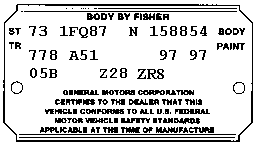
The Cowl Trim Tag, located on the cowl area identifies significant information about your car.
Line 1: Year, GM Division, Model & Body, Assembly Plant, Sequence Number
Line 2: Trim, Seat Type, Paint
Line 3: Build Month and Week | Norwood Only = Option Code, Stripe Code
1973 Camaro Paint Codes
Exterior Color Codes
Abbreviations: B = Blue, Bk = Black, Bkb = Black w/ Blue Accents, Bkg = Black w/ Green Accents, Bkw = Black w/ White Accents, C = Cloth, Ch = Chamois, G = Green, N = Neutral, R = Red, S = Saddle, V = vinyl, W = White

